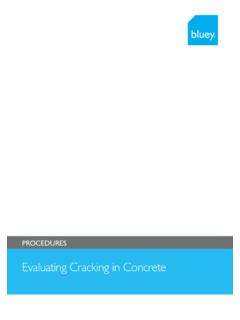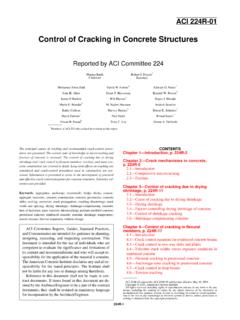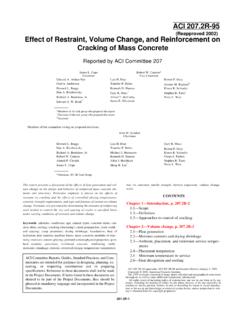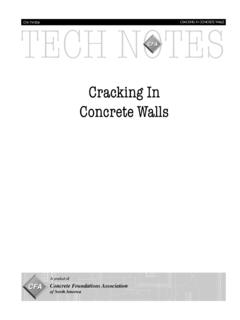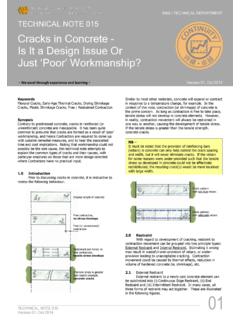Transcription of Temperatures
1 concrete international / JANUARY 2002 59BY JOHN GAJDA AND MARTHA VANGEEM pecifications generally limit Temperatures in massconcrete to prevent cracking and durability prob-lems. Temperature limits are specified to seeminglyarbitrary values of 135 F (57 C) for the maximumallowable concrete temperature and 35 F (19 C) for themaximum allowable temperature difference betweenthe center and surface of the mass concrete , the contractor must meet all of the specificationrequirements, but without a good understanding of massconcrete, keeping concrete Temperatures within limitscan be a difficult , well-established temperature control measuresare sufficient to meet project specifications.
2 However, ifthese are overlooked or poorly understood, they couldresult in concrete Temperatures and temperature differ-ences that greatly exceed specified limits, causing delaysto the construction schedule or damage to the , recent trends, such as increasing the size ofconcrete sections and requiring high minimum cementcontents or low water-cementitious materials ratios,make temperature control even more mass concrete is the key to controllingtemperatures and ultimately saving time, effort, and Mass ConcreteUnderstanding mass concrete is the key to controlling temperaturesand ultimately saving time, effort, and moneyWhat is mass concrete ?
3 A question often arises as to exactly what is consideredto be mass concrete . According to ACI 116R,1 mass concreteis defined as any volume of concrete with dimensionslarge enough to require that measures be taken to copewith generation of heat from hydration of the cement andattendant volume change, to minimize cracking . Because this definition doesn t provide a specificmeasure, many agencies have developed their owndefinitions of mass concrete . For example, mass con-crete is defined by some agencies as any concreteelement having a least dimension greater than 3 ft( m).
4 Under this definition, a large mat foundationwith a thickness of 3 ft ( m) would not be consideredmass concrete , but a large mat foundation with a thick-ness of ft (1 m) would be considered mass agencies use different minimum dimensions,ranging from to ft ( to m), depending onpast experience. Note that none of these definitionsconsiders the cementitious material content of theconcrete. Temperatures within a concrete element will bemuch different if high-performance or high-early-strengthconcrete is used rather than typical structural JANUARY 2002 / concrete internationalFor lack of a standard definition, we consider massconcrete to be any element with a minimum dimensionequal to or greater than 3 ft ( m).
5 Similar consider-ations should be given to other concrete elements thatdo not meet this definition but contain Type III cement orcementitious materials in excess of 564 lb/yd3 (335 kg/m3)of concrete . In many cases, these non-mass elements willalso generate significant amounts of concrete temperature andtemperature differenceMaximum allowable concrete Temperatures andtemperature differences are often specified to ensurethat proper planning occurs prior to concrete place-ment. In many cases, the specified limits are seeminglyarbitrary and do not consider project specifics.
6 As anexample of this, certain project specifications limit themaximum concrete temperature to 135 F (57 C), and limitthe maximum concrete temperature difference to 35 F(19 C). Other restrictions are often included, such aslimits on the maximum and minimum Temperatures ofdelivered concrete temperatureThe maximum concrete temperature is limited for avariety of reasons. The primary reason is to preventdamage to the concrete . Studies have shown that thelong-term durability of certain concretes can be compro-mised if the maximum temperature after placementexceeds the range of 155 to 165 F (68 to 74 C).
7 Theprimary damage mechanism is delayed ettringite forma-tion (DEF). DEF can cause internal expansion andcracking of concrete , which may not be evident forseveral years after reasons to limit the maximum concretetemperature include reducing cooling times andassociated delays, and minimizing the potential forcracking due to thermal expansion and over 190 F (88 C) can also reduceexpected compressive temperature differenceA maximum allowable concrete temperature differenceis often specified to minimize the potential for thermalcracking. This temperature difference is the differencebetween the temperature at the hottest portion of theconcrete and that at the surface.
8 Thermal cracking willoccur when contraction due to cooling at the surfacecauses tensile stresses that exceed the tensile strengthof the maximum allowable temperature difference of 35 F(19 C) is often specified in contract documents. Thistemperature difference is a general guideline based onexperience with unreinforced mass concrete placed inEurope more than 50 years many situations, limiting the temperature differenceto 35 F (19 C) is overly restrictive; thermal cracking maynot occur even at higher temperature differences. In othercases, significant thermal cracking may still occur evenwhen the temperature difference is less than 35 F (19 C).
9 The maximum allowable temperature difference is afunction of concrete mechanical properties such asthermal expansion, tensile strength, and elastic modulus,as well as the size and restraints of the concrete provides guidance on calculating the maxi-mum allowable temperature difference to preventthermal cracking based on the properties of the concreteand for a specific 1 compares the typically specified 35 F (19 C)maximum allowable temperature difference with that ofthe calculated maximum allowable temperature differ-ence for a specific mat foundation.
10 As the concretereaches its design strength, the calculated maximumallowable temperature difference is much greater than 35F (19 C). Use of the calculated maximum allowabletemperature difference can significantly reduce theamount of time that protective measures, such as surfaceinsulation, must be kept in concrete temperaturesSpecifications for mass concrete often require particularcement types, minimum cement contents, and maximumsupplementary cementitious material contents. Oncethis information is available, the process of predictingmaximum concrete Temperatures and temperaturedifferences can begin.
